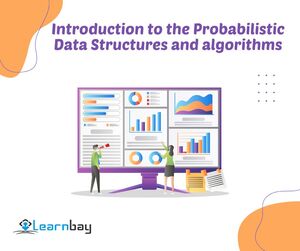Introduction To Probabilistic Data Structures And Algorithms
Body
The family of complex techniques known as the Probabilistic data structures and algorithms (PDSA) frequently employ hashing and have many other advantageous properties. They are optimized to use fixed or sublinear memory and constant processing time. But they also have some drawbacks, like they can't give precise solutions and have a chance of making mistakes. (that, can be controlled). The trade-off between mistakes and resources is another characteristic that sets apart all algorithms and data structures in this family.
These technologies have naturally found applications in big data, where there is a trade-off: either leave the entire data unprocessed or accept that some findings are not entirely accurate. Further, you can check out Learnbay’s data structures and algorithms course to upgrade your DSA skills for your coding interviews.
Here are some instances of Probabilistic Data structures:
Bloom filters: Using a probabilistic data structure to determine whether an element is part of a collection.
Count-Min Sketch: an estimation of the frequency of each constituent in a dataset using a probabilistic data structure.HyperLogLog: a statistical data structure that calculates the number of unique elements in a dataset
To provide approximations to queries while utilizing a finite amount of storage and computation, these data structures function by using randomization and hashing. Numerous applications, including database administration, network security, and data analytics, frequently use probabilistic data structures.
The main benefit of probabilistic data structures is their capacity to handle massive amounts of data in real-time by responding to inquiries with approximations using little space and computation. However, there is no guarantee of their accuracy, so when selecting a probabilistic data structure for a particular use case, the trade-off between accuracy and efficiency must be carefully examined.
Limitations of storage
Let's now talk about the situation in terms of the developer. If we want to keep something in memory, we can use a Set (although other in-memory data structures can be used as well, such as Arrays, Lists, Maps, etc.), and if we want to store something on SSD, we can use a relational database or elastic search. Similar to how we can use Hadoop for a hard disc (HDD).(HDFS). Now let's say we want to use deterministic in-memory data structures to store data in memory, but the problem is that the amount of memory we have on servers in terms of GB or TB for memory is less than SSD, and SSD might have less memory than a hard drive (HDD). Additionally, one should keep in mind that while deterministic data structures are good and widely used, they are inefficient in consuming memory.
Deterministic Vs. Probabilistic Data structures
As IT professionals, we may have encountered a variety of predictable data structures, including Array, List, Set, HashTable, HashSet, etc. These in-memory data structures are the most prevalent ones on which different actions, such as insert, find, and delete, could be carried out with particular key values. We obtain the deterministic(accurate) result due to the operation. However, this is not the situation when using a probabilistic data structure, as the operation's outcome here could be a probabilistic data structure is one that yields approximate results and is therefore probabilistic (you might not get a clear response from it).
The following parts will demonstrate and substantiate this. Let's examine its definition, varieties, and applications in more depth for now. How does it function? When working with large data sets, probabilistic data structures can be used to identify the most frequent item, the unique items in the data set, or even whether or not certain items exist. Probabilistic data structures use increasing hash functions to randomize and represent a set of data to perform this process.
Tips to Remember
All the actions a probabilistic data structure can perform, but only with small data sets, can also be performed by a deterministic data structure. As previously mentioned, the deterministic data structure fails and is impossible if the data collection is too large and cannot fit into the memory. It is very challenging to manage the deterministic data structure in the case of a streaming application where data processing in one step and incremental updates are needed.
Applications
- Big data collection analysis
- Statistical analysis
- Mining tetra-bytes of datasets
Benefits of Probabilistic Data Structures
- Scalability: Big data applications can benefit from using probabilistic data structures because they can manage large data volumes.
- Simplicity: Given their ease of implementation, probabilistic data structures are useful for various coders and use cases.
- Space efficiency: Area efficiency In comparison to conventional data structures, probabilistic data structures are more memory efficient because they are made to occupy a small amount of area.
- Reduced computation: Comparatively less computation is needed than with exact algorithms thanks to the use of hashing and randomization in probabilistic data structures, which approximates the results.
- Trade-off between accuracy and efficiency: Accuracy and speed can be balanced to suit a particular use case using probabilistic data structures, which offer a trade-off between the two.
- Real-time performance: Probabilistic data structures are appropriate for use in real-time applications because they are made to approximate responses to queries in real-time.
Final words!
All in all, Probabilistic data structures are a popular option for many applications because they offer a powerful tool for managing massive amounts of data in real-time. If you are planning to learn data structures and algorithms from the ground up, enroll in the best DSA course and become confident in your next technical interviews.















Comments